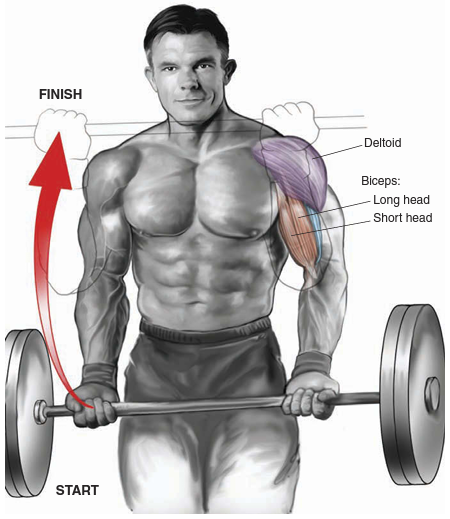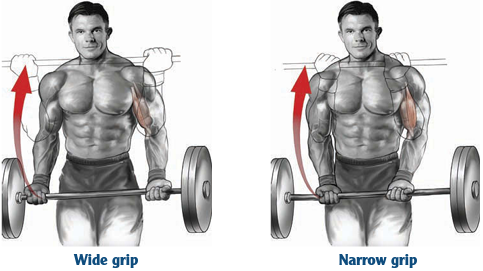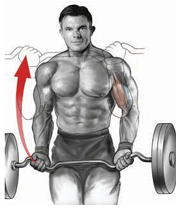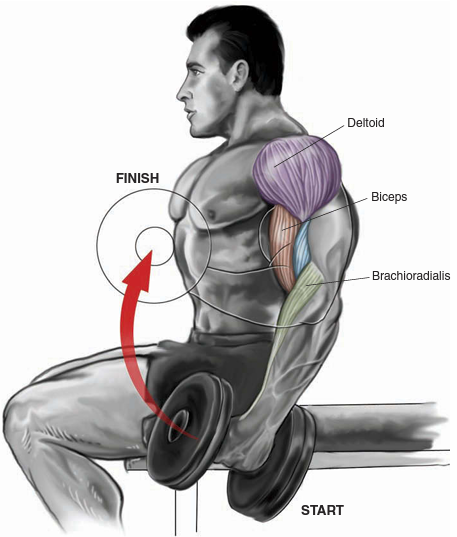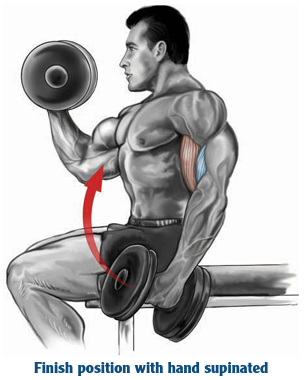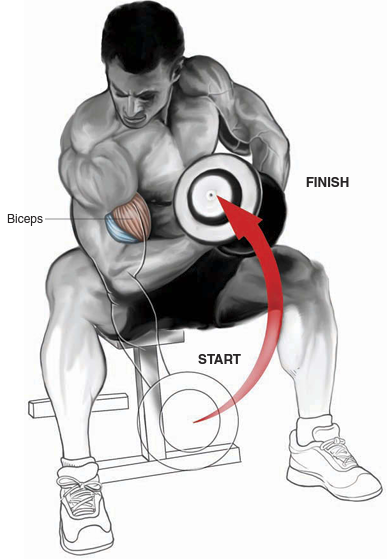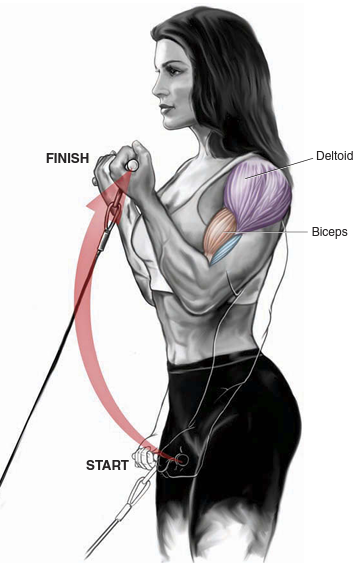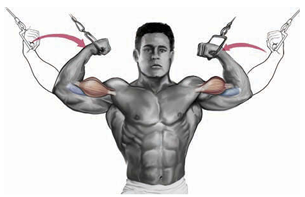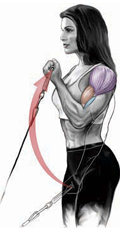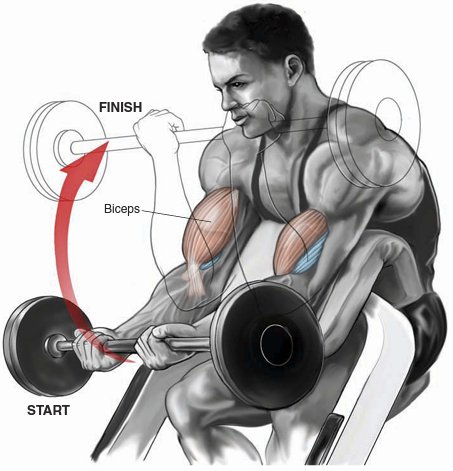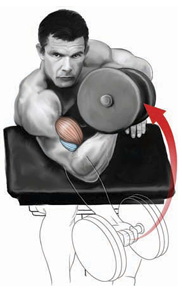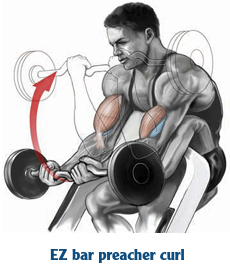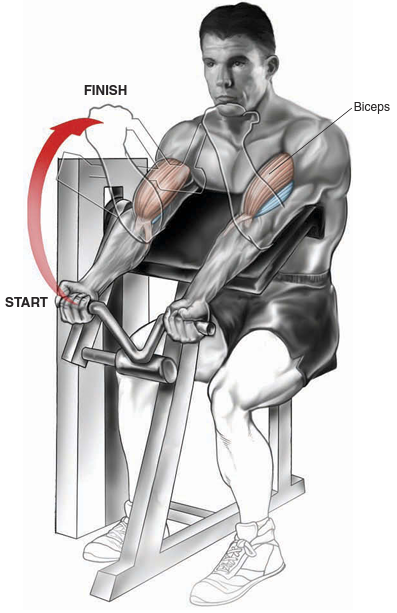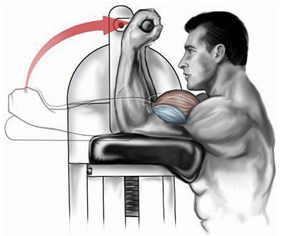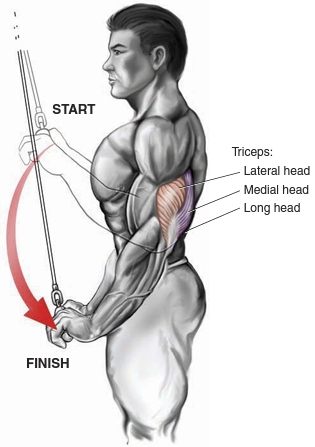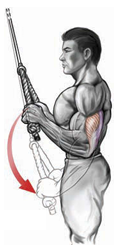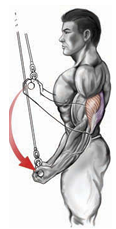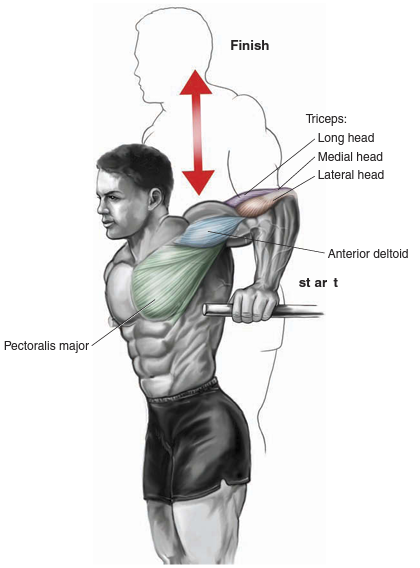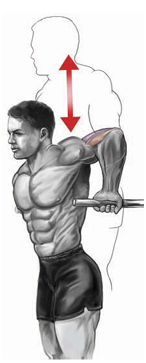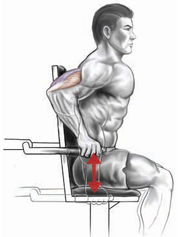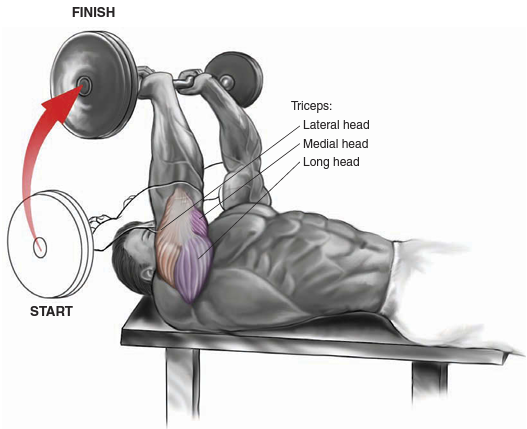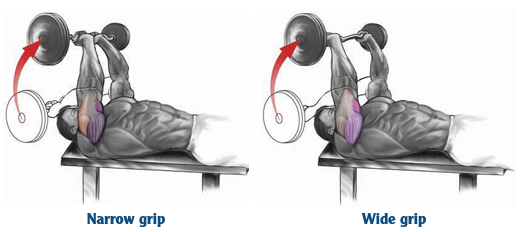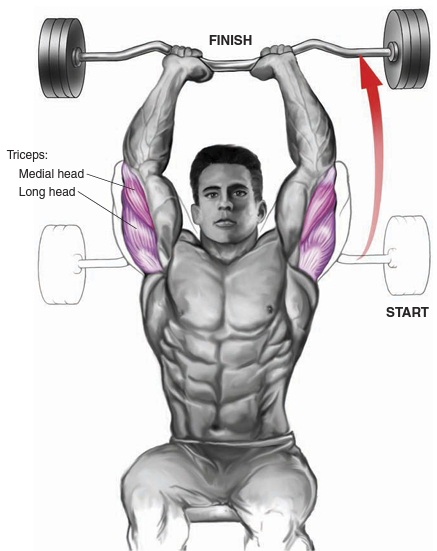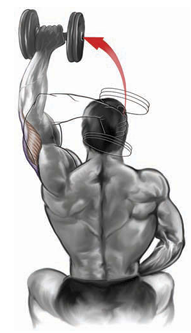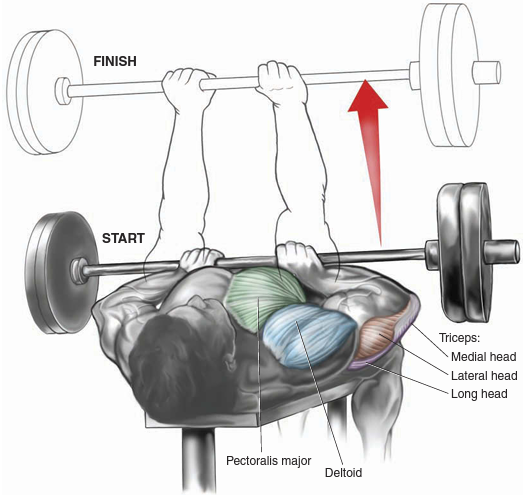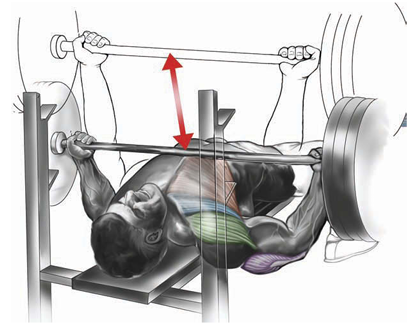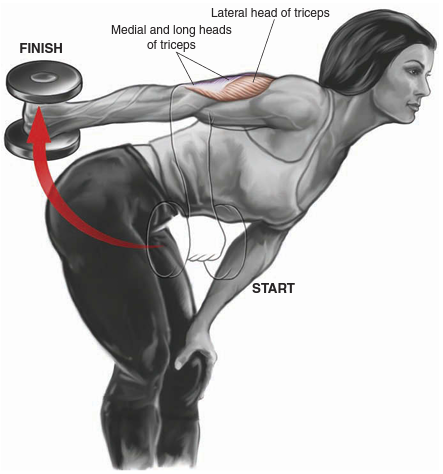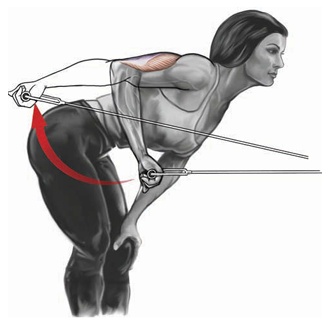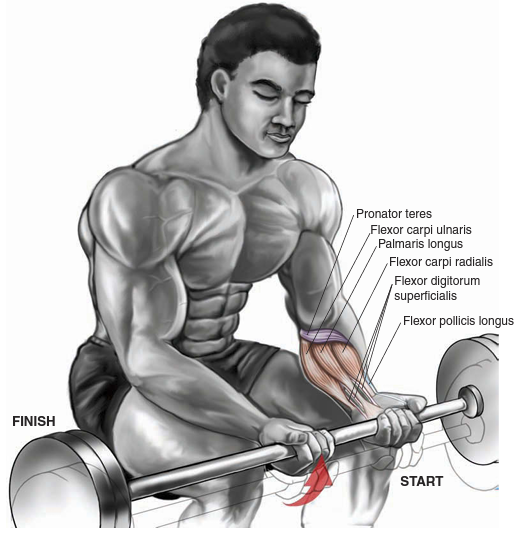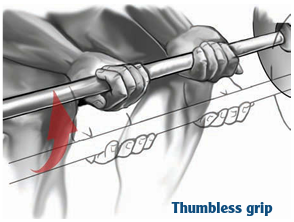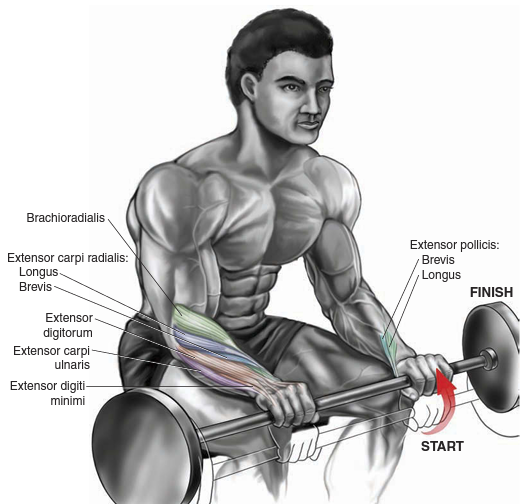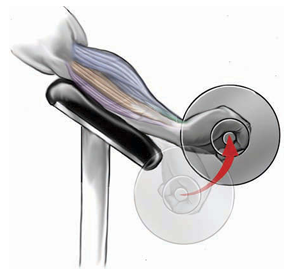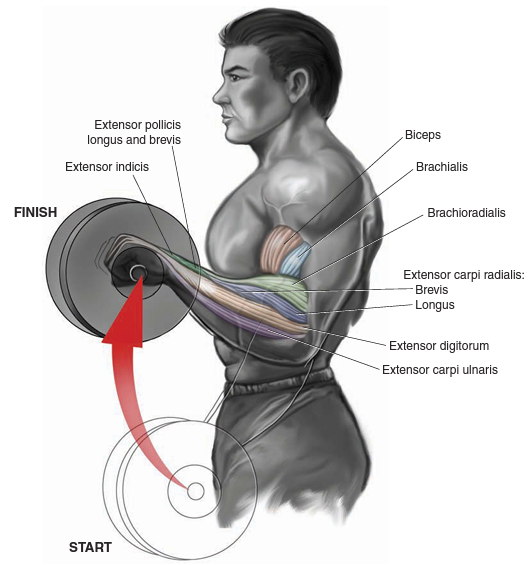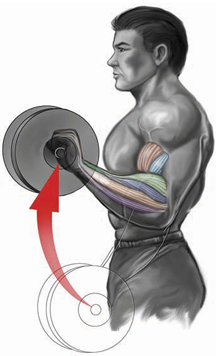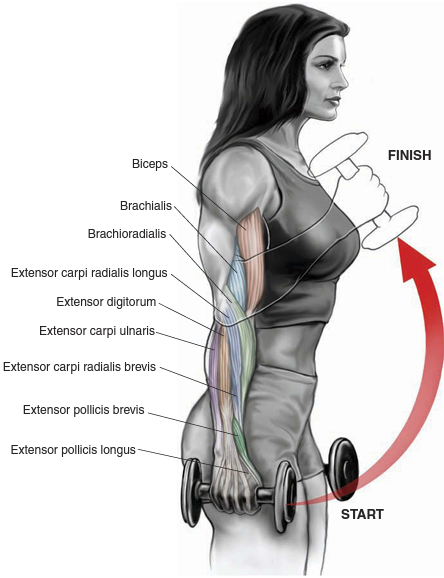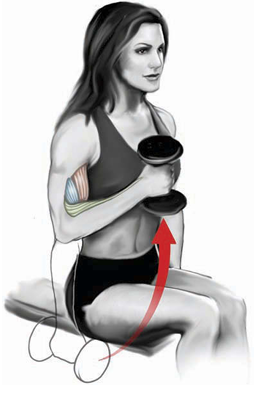Arms
Barlbell Curl
Execution
1. Hold a barbell at arms’ length, using a shoulder-width underhand grip.
2. Curl the bar up to shoulder level by bending your elbows.
3. Lower the bar back down to the arms’ extended position.
Muscles Involved
Primary: Biceps.
Secondary: Brachialis, brachioradialis, anterior deltoid, forearm.
Anatomic Focus
Hand spacing: A wide grip focuses effort on the inner biceps (short head), whereas a narrow grip works the outer biceps (long head).
Grip: With a straight bar, the underhand grip is fixed in supination (palms upward). Grip may be adjusted using an EZ bar (see Variation section).
Trajectory: The bar should move up and down in an arc close to the body. To isolate the biceps, motion should occur at the elbow and not the shoulder.
Range of motion: Stopping a few degrees short of full elbow extension keeps tension on the biceps as the barbell is lowered.
Body position: Stand upright with the spine straight. Tilting the torso is often used as a method of cheating the bar upward with momentum. Leaning slightly forward makes the initial phase of the curl easier. Leaning slightly backward helps complete the final phase of the repetition.
VARIATIONS
EZ Bar CurI
Performing the curl with an EZ bar changes the grip. The hands switch from the fully supinated (palms up) grip to a less supinated, nearly neutral grip (palms facing in). This hand position emphasizes the outer (long) head of the biceps and the brachial is, and it is less strenuous on the wrist joint.
Dumbbell Curl
Execution
1. Hold a pair of dumbbells at arms’ length by your sides, thumbs pointing
2. One arm at a time, curl the dumbbell up toward your shoulder, rotating your hand so the palm faces upward.
3. Lower the dumbbell back down, and repeat with the opposite arm.
Muscles Involved
Primary: Biceps.
Secondary: Brachialis, brachioradialis, anterior deltoid, forearm .
Anatomic Focus
Grip: The dumbell curl works the biceps in two ways: elbow flexion and forearm supination . Hence, to maximize biceps contraction, supinate the hand (palm uppermost) as he dumbbell is raised.
Hand spacing: Instead of grasping the dumbbell in the middle of the bar, slide your palm over so your thumb rests against the inside of the plate. This grip change increases the load on the biceps during supination, activating more muscle fibers when the dumbbell is rotated.
Trajectory: Position your torso upright with the spine straight. Tilting the torso is often used as a method of cheating the weight upward with momentum. Leaning slightly forward makes the initial phase of the curl easier. Leaning slightly backward helps complete the final phase of the repetition.
Range of motion: Use a full range of motion at the elbow.
VARIATIONS
Standing dumbbell curl: This exercise can be performed in a standing position, but this requires muscular effort in the legs. The seated version of the exercise (illustrated) affords better focus.
Incline dumbbell curl: When performed while seated on an incline bench, effort is focused on the lower portion of the biceps, near the elbow.
Concentration Curl
Execution
1. Sit on the edge of a bench. Hold a dumbbell at arm’s length, supporting your arm against the inside of your thigh.
2. Curl the dumbbell up toward your shoulder by bending at the elbow.
3. lower the dumbbell back down to the start position.
Muscles Involved
Primary: Biceps.
Secondary: Brachialis, brachioradialis, forearm muscles.
Anatomic Focus
Grip: An underhand grip places the hand in supination and thereby maximizes biceps contraction.
Trajectory: The position of the upper arm (relative to the floor) changes the focus of effort. When the arm is vertical (shoulder directly above the elbow), resistance increases as the dumbbell is raised, and effort is focused on the upper biceps (peak). With the arm at an inclined angle (elbow in front of the shoulder), resistance is maximal at the start, so effort is targeted on the lower section of the biceps at the elbow.
Range of motion: Resting the upper arm against the thigh prevents movement at the shoulder and is an excellent way to isolate the biceps.
Body position: The torso should remain motionless, supported by your free hand on the opposite thigh.
VARIATIONS
One-ann cable curl: You can also perform a concentration curl while using a D-handle attached to the cable of a low pulley.
Cable Curl
Execution
1. Grasp the short bar attached to a low pulley, using an underhand grip with arms straight.
2. Curl the bar up toward your shoulders by bending at the elbows.
3. Lower the weight down to the arms’ extended position.
Muscles Involved
Primary:Biceps.
Secondary: Brachialis, brachioradialis, anterior deltoid, forearm.
Anatomic Focus
Hand spacing:A wider-than -shoulcler-width grip focuses effort on the inner biceps (short head), whereas a narrow grip works the outer biceps (long head).
Grip: With a straight bar, the underhand grip is fixed in supination (palms upward). Using an EZ bar attachment, grip switches from the fully supinated position to a less supinated, nearly neutral grip (palms fadng in). This hand position is less strenuous on the wrist joint and tends to emphasize the outer (long) head of the biceps and the brachialis musde.
Body position: Stand upright with the spine straight.
Range of motion: Fixing the elbows against your sides prevents movement at the shoulder and is an excellent way to isolate the biceps.
Resistance: Unlike barbell or dumbbell curls where the resistance varies during the lift, the cable pulley provides a uniform resistance throughout the
VARIATIONS
High-Pulley Curl
Grasp the D-handles attached to two high pulleys using an underhand grip, and stand midway between the pulleys. With your arms held at shoulder level, curl the handles toward your head. This version emphasizes the long head of the biceps and works the biceps peak.
One-Arm Cable Curl
Perform the exercise one arm at a time using a D-handle attached to the low pulley.
Preacher CurI
Execution
1. Sit with your upper arms resting on the preacher bench, and take a shoulder-width underhand grip on the bar with arms out straight.
2. Curl the bar up toward your shoulders.
3. Lower the weight back down to the arms’ extended position.
Muscles Involved
Primary:Biceps.
Secondary:Brachialis, brachioradialis, forearm.
Anatomic Focus
Hand spacing: A wide grip focuses effort on the inner biceps (short head), whereas a narrow grip works the outer biceps (long head).
Grip: With a straight bar, the underhand grip is fixed in supination (palms upward) You may adjust the grip using an EZ bar.
Trajectory: With the upper arms supported at an incIined angle, resistanc is maximal at the start, so effort i targeted on the lower section of the biceps near the eIbow
Range of motion: Resting the upper arms on the bench prevents movement at the shoulders and the thereby helps iso late the biceps, Stopping a few degrees short of full elbow extension keeps tension on the biceps as the barbell is lowered.
Body position: Adjust the seat height so that your armpit is snug against the upper edge of the pad.
VARIATIONS
Dumbbell Preacher Curl
Performing the exercise one arm at a time with a dumbbell improves focus and isolation,
EZ Bar Preacher Curl
Using an EZ bar, the grip switches from the fully supinated (palms up) position to a less supinated, nearly neutral grip (palms facing in), This hand position tends to focus effort on the outer (long) head of the biceps and the brachialis muscle, and it is less strenuous on the wrist joint.
Machine Curl
Execution
1. Grasp the bar using a shoulder-width underhand grip. with your elbows resting on the pad and arms out straight.
2. Curl the bar toward your shoulders by bending at the elbow.
3. Return the bar to the arms’ extended position.
Muscles Involved
Primary: Biceps.
Secondary: Brachialis, brachioradialis, forearm.
Anatomic Focus
Hand spacing: A wide grip focuses effort on the inner biceps (short head), whereas a narrow grip works the outer biceps (long head).
Grip: An angled handlebar is less strenuous on the wrist joint
Trajectory: Depending on the design of the machine, an indine arm pad focuses effort on the lower portion of the biceps, whereas a flat horizontal pad emphasizes the middle-biceps peak.
Range of motion: Effort focuses on the lower biceps during the initial phase of the curi, then switches to the middle biceps (peak) as the weight is raised.
Resistance: Unlike barbell or dumbbell curls, where the resistance varies during the lift, the machine provides a uniform resistance throughout the
VARIATIONS
Flat-Pad Machine Curl
In contrast to an indine arm pad, the trajectory of a flat horizontal arm pad focuses on the biceps peak.
Additional variation:
One-arm machine curl:
Performing the exercise one arm at a time improves focus and isolation.
Triceps Pushdown
Execution
1. Take a shoulder-width overhand grip on a short bar attached to the high
2. Begin with the bar at chest level, elbows bent a little more than 90 degrees.
3. Keeping your upper arms stiff, push the bar down until your elbows lock out
Muscles Involved
Primary: Triceps.
Secondary: Deltoid, forearm.
Anatomic Focus
Hand spacing: A wide grip focuses effort on the inner triceps (long head), whereas a narrow grip focuses on the outer triceps (lateral head).
Grip: Using the straight bar, a pronated grip (palms down) emphasizes the outer lateral head of the triceps, whereas a supinated grip (palms up) focuses effort on the inner long head. An angled V-shaped bar switches the hands into a neutral grip (thumbs up) that targets all three heads of the triceps equally.
Trajectory: With the upper arms perpendicular to the floor. the outer triceps (lateral head) contributes to the movement. If you perform the exercise with your arms raised parallel to the floor. you focus effort on the inner triceps (long head).
Range of motion: Fixing the upper arms against your sides prevents movement at the shoulder and is an excellent way to isolate the triceps. Motion should occur through the elbow only.
Resistance: Unlike barbell or dumbbell exercises. where the resistance varies during the lift. the cable provides a uniform resistance throughout the movement.
Body position: Standing upright with the spine straight is the standard position. Leaning the torso slightly forward at the waist provides better stability when using heavier weights.
VARIATIONS
Rope Pushdown
The rope attachment affords a forcible pronation at the wrist. which targets the outer lateral head of the triceps.
Reverse-Grip Pushdown
A reverse underhand grip focuses effort on the inner long head of the triceps.
Additional variation:
One-arm pushdown: Performing the exercise one arm at a time with the D-handle, using an overhand or underhand grip. focuses effort and improves isolation.
Dip
Execution
1. Grasp the parallel bars and lift yourself up until your arms are fully
2. Bend your elbows and slowly lower your body until your upper arms are parallel to the floor; keep your torso upright.
3. Push yourself back up, straightening your arms until the elbows lock out.
Muscles Involved
PrImary: Triceps.
Secondary: Chest, anterior deltoid, forearm.
Anatomic Focus
Hand spacing: When the apparatus allows, a wide grip focuses effort on the inner triceps (long head), whereas a narrow grip focuses on the outer triceps (lateral head).
Grip: The standard grip, palms facing together with thumbs forward, hits all three heads of the triceps, with an emphasis on the inner long head. Reversing the grip so that the palms face outward with thumbs facing back switches most of the effort to the outer triceps (long head).
Trajectory: Keeping the elbows close to your sides helps isolate the triceps. Flaring the elbows out wide allows the chest muscles to assist.
Range of motion: To isolate the triceps, movement should occur primarily at the elbow, so keep motion at the shoulder to a minimum.
Body position: To focus effort on the triceps, keep your body upright. Leaning forward makes the chest muscles do more work.
Resistance: Resistance is provided by your body weight and is not easily adjusted. You can add resistance by attaching a weighted belt around your hips.
VARIATION
Machine Dip
Performing the exercise while seated in the triceps pushdown (dip) machine, where the resistance is adjustable, makes it easier to focus your effort on the triceps. All the tips mentioned previously for the parallelbar dip also apply to the machine variation.
Lying Triceps Extension
Execution
1. Lying on a flat bench, hold a barbell at arms’ length above your chest with a narrow overhand grip, hands approximately 6 inches (15 em) apart.
2. Bend at the elbows and lower the bar down to touch your forehead.
3. Push the bar upward until your elbows lock out.
Muscles Involved
Primary: Triceps.
Secondary: Chest, deltoid, forearm.
Anatomic Focus
Hand spacing: A wide grip emphasizes the inner triceps (long head), whereas a narrow grip targets the outer triceps (lateral head). Keep the elbows close, and do not allow them to flare outward to the sides.
Grip: Using a straight bar, you may perform this exercise with an overhand (pronated) grip or an underhand (supinated) grip. Using an EZ bar or dumbbells (see Variations section) requires a neutral grip. An overhand grip works the inner (long) head, an underhand grip emphasizes the outer (lateral) head, and a neutral grip works all three heads of the triceps.
Trajectory: The vertical position of the arm stretches the inner (long) head of the triceps, so this exercise targets this section of the muscle. Lowering the bar beyond the forehead toward the bench generates a greater stretch in the long head, favoring its contraction during the movement.
Body position: Keep your elbows pointing up and upper arms vertical. Do not lower the bar toward your face or chin, because this causes the elbows to drop and allows the deltoid and pectoral muscles to assist in the
Range of motion: To isolate the triceps, motion should occur only at the elbow, not at the shoulder.
VARIATIONS
Dumbbell lying triceps extension: Perform the exercise with a dumbbell in each hand; thumbs should pOint toward your face (neutral grip).
Reverse grip: You can also perform the exercise while using a reverse (supinated) grip on the bar to emphasize the outer (lateral) head of the triceps.
Seated Triceps Press
Execution
1. Sit upright while holding a barbell in both hands at arms’ length above your head use a narrow overhand grip.
2. Bend at the elbows and lower the bar down behind your head.
3. Push the bar upward until your elbows lock out.
Muscles Involved
Primary: Triceps.
Secondary: Deltoid, forearm.
Anatomic Focus
Hand spacing:A wide grip emphasizes the inner triceps (long head), whereas a narrow grip targets the outer triceps (lateral head). Keep the elbows close together, and do not allow them to flare outward.
Grip: Using a straight bar, this exercise requires an overhand (pronated) grip. Using an EZ bar or a dumbbell (see the Variations section) requires a neutral grip. An overhand grip works the inner (long) head, whereas a neutral grip works all three heads of the triceps.
Trajectory: The vertical position of the arm stretches the inner long head of the triceps, so this exercise preferentially targets this section of the muscle.
Range of motion: To isolate the triceps, motion should occur at the elbow.
Safety: The triceps extension exercise poses two safety concerns. First, it places excessive stretch on the triceps tendon; second, it places the shoulder joint in a vulnerable position for injury. Therefore, it is not the best exercise choice for people who have elbow or shoulder pain.
Single-Dumbbell Seated Triceps Press
You may perform this exercise one arm at a time while holding a dumbbell with the palm facing forward to emphasize the outer (lateral) head of the triceps.
Additional variation:
EZ bar triceps press: Performing this movement with an EZ bar offers a variety of grip choices.
Close-Grip Bench Press
Execution
1. Take a narrow (6-inch, or 15-centimeter) overhand grip on the bar.
2. Lower the weight down slowly to touch the middle chest.
3. Push the bar straight up until your elbows lock out.
Muscles Involved
Primary: Triceps, pectoralis major.
Secondary: Anterior deltoid.
Anatomic Focus
Hand spacing:To target the trice ps, hand spacing should be narrower than shoulder width.
Grip: An underhand (supinated) grip on the bar also targets the triceps, but this grip requires the hands to be spaced wide apart (see Variation section).
Trajectory: Keep your elbows close to your sides to emphasize the triceps, not the chest.
Range of motion: A full range of motion (achieving full lockout) is required for maximizing triceps effort.
VARIATIONS
Reverse Grip Bench Press
Performing the bench press using an underhand grip (palms facing up) with hands spaced more than shoulder-width apart also targets the triceps.
Dumbbell Kickback
Execution
1. Grab a dumbbell in one hand, bend forward at the waist, and support your torso by resting your free hand on a bench or on your knee.
2. Begin with your upper arm parallel to the floor and elbow bent at 90
3. Raise the dumbbell upward, straightening your arm until the elbow locks
Muscles Involved
Primary: Triceps.
Secondary: Rear deltoid, latissimus dorsi.
Anatomic Focus
Grip: A neutral grip (thumb forward) works all sections of the triceps. Rotating the dumbbell so your palm faces up targets the outer (lateral).
Trajectory: Keep the upper arm parallel to the floor and the elbow close to your side.
Range of motion: To isolate the triceps, movement should occur at the elbow, and the shoulder should remain stiff.
Resistance: Because of the effect of gravity, resistance is variable and increases as the dumbbell is raised upward.
Body position: Your torso should be slightly above parallel to the floor. If you stand too upright, you can’t perform the exerdse effectively.
VARIATIONS
Cable Kickback
You can perform this exercise while using a D-handle attached to a low pulley. Unlike the dumbbell version, where the resistance varies during the lift, the cable provides a uniform resistance throughout the movement.
Wrist Curl
Execution
1. While seated on the edge of a bench, grasp a barbell with a shoulder-width underhand grip, and rest the back of your forearms on your thighs.
2. Lower the bar by bending your wrists down toward the floor.
3. Curl the weight up by using wrist motion.
Muscles Involved
Primary: Forearm flexors.
Secondary:Finger flexors.
Anatomic Focus
Hand spacing: The ideal hand spacing is shoulder width or slightly narrower. Your hands should be directly in line with your forearms to minimize unnecessary stress in the wrist joint.
Grip: This exercise requires an underhand (supinated) grip with the palms facing upward. Your thumbs may grip under or over the bar, depending on personal preference. One advantage of a “thumbless” grip is that it allows you to lower the bar farther, increasing the range of motion.
Range of motion: Letting the bar roll down your fingers during the lowering phase of the repetition increases the range of motion. As the bar is curfed upward, the finger flexors work as you finger-curf the bar into your palm, and then the forearm flexors work as you curf the wrist upward. Because the finger flexors make up a significant portion of the forearm muscles, this extended repetition is more effective for building forearm mass.
Trajectory: Changing the position of your forearms in relation to the floor alters the resistance and adjusts the focus of the exercise. When your forearms are flat and parallel to the floor, resistance is maximal at the beginning and decreases as the bar is lifted upward. When your forearms make an angle with the floor, such that your elbows are higher than your wrists, resistance is minimal at the start and increases as the bar is curled up. This second variation is more effective at maximizing forearm contraction.
Body position: Your forearms may be supported in different positions:
1. Between your legs on a flat bench
2. On top of your thighs while seated on a bench
3. On the incline pad of a preacher bench
VARIATIONS
Dumbbell wrist curl: You can also perform this exercise one arm at a time while using a dumbbell.
Preacher bench wrist curl: Perform the exercise with your forearms resting on the incline pad of a preacher bench.
Reverse Wrist CurI
Execution
1. Grasp a barbell using an overhand grip, and rest your forearms on top of your thighs or on the edge of a bench.
2. Lower the bar by bending your wrists toward the floor.
3. Raise the weight up using wrist motion.
Muscles Involved
Primary: Forearm extensors.
Secondary: Finger extensors and flexors.
Anatomic Focus
Hand spacing: The ideal hand spacing is shoulder width or narrower. Your hands should be directly in line with your forearms.
Grip: This exercise requires an overhand (pronated) grip with the palms fating down and your thumbs gripped around the bar.
Trajectory:Changing the position of your forearms in relation to the floor alters the resistance and adjusts the focus of the exercise. When your forearms are flat and parallel to the floor, resistance Is maximal at the beginning and decreases as the bar is lifted upward. When your forearms make an angle with the floor such that your elbows are higher than your wrists, resistance is minimal at the start and increases as the bar Is curled up. This second variation is more effective at maximizing forearm
Range of motion: Use a full range of motion to maximize forearm effort.
Body position: Your forearms may be supported in different positions:
1. Between your legs on a flat bench
2. On top of your thighs while seated on a bench
3. On the incline pad of a preacher bench
4. Held parallel to the floor (unsupported) in the standing curl position
VARIATIONS
Dumbbell Reverse Wrist Curl
You can also perform this exercise one arm at a time while using a dumbbell.
Additional variation:
Preacher bench: Perform the exercise with your forearms resting on the incline pad of a preacher bench.
Reverse Barbell Curl
Execution
1. Hold a barbell at arms’ length using a shoulder-width overhand grip.
2. Raise the bar up toward shoulder level, cuning your wrists up and back as you bend the elbows.
3. Lower the bar back down to the arms’ extended position, dropping the
Muscles Involved
Primary:Forearm extensors, fi nger extensors.
Secondary: Biceps, brachioradialis, brachialis.
Anatomic Focus
Grip: This exercise requires an overhand (pronated) grip with the palms facing down and your thumbs gripped around the bar.
Hand spacing: The ideal hand spacing is shoulder width with your hands directly in line with your forearms.
Range of motion: To maximize forearm involvement, be sure to achieve a full range of motion at the wrist. Cock the wrist back into full extension as the bar is raised, and flex the wrist down as the weight is lowered.
Resistance: Because of gravity, resistance increases as the bar is raised upward. To ensure maximum forearm effort, delay the wrist extension curl until the forearms are parallel to the floor.
VARIATIONS
Reverse dumbbell curl: You can also perform this exercise while using dumbbells with an overhand, pronated grip.
Wrist roller: Attach a small weight plate to the center of a short broomstick using a strong rope. Holding the broomstick out in front of you, wrist-curf the rope around the stick, thereby raising the weight upward.
Hammer Curl
Execution
1. Hold a dumbbell in each hand with your palms facing inward (thumbs pointing forward).
2. Curl one dumbbell at a time up toward your shoulder, keeping your palms facing inward.
3. Lower the dumbbell back down to the arm’s extended poSition, and repeat with the opposite arm.
Muscles Involved
Primary: Brachioradialis.
Secondary: Brachialis, forearm extensors and flexors, biceps.
Anatomic Focus
Grip: This exercise requires a neutral grip with the palms fadng inward, thumbs wrapped around the dumbbell bar.
Range of motion: To maximize forearm effort, work your wrist In the vertical plane, cocking your thumb upward as the dumbbell Is raised.
Trajectory: To focus effort on the brachioradlalls, raise the dumbbell across the front of your body rather than at your side.
From book: Bodybuilding anatomy, Nick Evans, 2007

